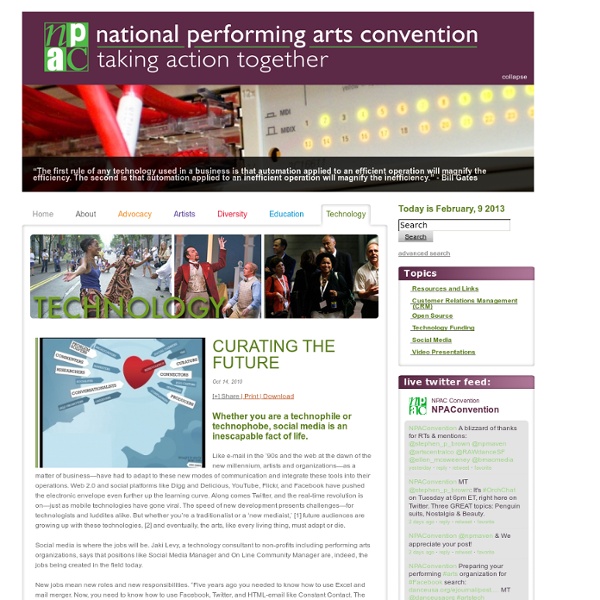Nation Performing Arts Convention
Like e-mail in the ‘90s and the web at the dawn of the new millennium, artists and organizations—as a matter of business—have had to adapt to these new modes of communication and integrate these tools into their operations. Web 2.0 and social platforms like Digg and Delicious, YouTube, Flickr, and Facebook have pushed the electronic envelope even further up the learning curve. Along comes Twitter, and the real-time revolution is on—just as mobile technologies have gone viral. Social media is where the jobs will be. New jobs mean new roles and new responsibilities. “Managing communities is much more complex than traditional outreach,” Levy added. Keeping track of all the important discussions and news and other relevant audience engagement—disseminated via channels like Facebook, Twitter, YouTube, Vimeo, and myriad others—requires more than just technical and social skills. You can Retweet, favorite, or copy urls, but it’s not the same.
The Conversation Prism by Brian Solis and JESS3
Content Curation & Fair Use: 5 Rules to being an Ethical Content Curator
* Update: I have a much lengthier updated post that incorporates the material below: Content Curation: Copyright, Ethics, & Fair Use Recently, Kimberley Isbell of the Nieman Journalism Lab cited a Harvard Law report and published an extensive post on news aggregation and legal considerations. From a curation perspective, the whole article is interesting, but what was the most surprising was that her recommendations for being an ethical content aggregator, were the same as being an effective content curator. The five recommendations are below. You can read the full article for the legal justifications for abiding by these practices. 1. Marketing reason: The more you link to third parties, the more likely they are to link back to you – which ultimately improves your SEO. 2. Marketing reason: A good content curator is selective an only links to the most relevant content on a specific topic or issue. 3. 4. 5. *Disclaimer: I am not a lawyer.
A Marketer’s Guide to Content Curation
There is an elephant in the online marketing “room,” and the elephant’s name is Curation. Curation is the most important part of online marketing that no one is talking about. With the rise of inbound marketing, content has become front and center in the minds of marketers. This focus on content as an important marketing tactic creates two extremely important problems. First, content creation is difficult. Applying Curation to Our Problems As marketers, how do we solve these two problems? Curation has become a fixture for many successful news blogs on the web today. Examples of Curation Some of the most popular posts on this blog have been from curated content. 3 Rules for Great Curation 1. 2. 3. Integrating Curation Into the Content Mix Curation has many applications. How do you use curation for your inbound marketing efforts? Photo Credit: joyosity
PJA Radio
Content Curation: Why Is The Content Curator The Key Emerging Online Editorial Role Of The Future?
What is content curation and why is it so important for the future of web content publishers? The content curator is the next emerging disruptive role in the content creation and distribution chain. In a world submerged by a flood of information, content curators may provide in the coming months and years a new, tremendously valuable service to anyone looking for quality information online: a personalized, qualified selection of the best and most relevant content and resources on a very specific topic or theme. Photo credit: Luna Vandoorne Vallejo In other words, a content curator is someone "who continually finds, groups, organizes and shares the best and most relevant content on a specific issue online". The most important component of this job is the word "continually." This is how marketing expert Rohit Bhargava defines what he thinks is one of the key emerging online editorial roles of the future. But don't take my word for it. Intro by Robin Good by Rohit Bhargava About Rohit Bhargava
The Seven Needs of Real-Time Curators
I keep hearing people throw around the word “curation” at various conferences, most recently at SXSW. The thing is most of the time when I dig into what they are saying they usually have no clue about what curation really is or how it could be applied to the real-time world. So, over the past few months I’ve been talking to tons of entrepreneurs about the tools that curators actually need and I’ve identified seven things. But NONE of the real time tools/systems like Google Buzz, Facebook, Twitter, YouTube, Flickr, give curators the tools that they need to do their work efficiently. As you read these things they were ordered (curated) in this order for a reason. This is a guide for how we can build “info molecules” that have a lot more value than the atomic world we live in now. Thousands of these atoms flow across our screens in tools like Seesmic, Google Reader, Tweetdeck, Tweetie, Simply Tweet, Twitroid, etc. A curator is an information chemist. 1. 2. 3. 4. 5. 6. 7. 1. 1.
Related:
Related:



